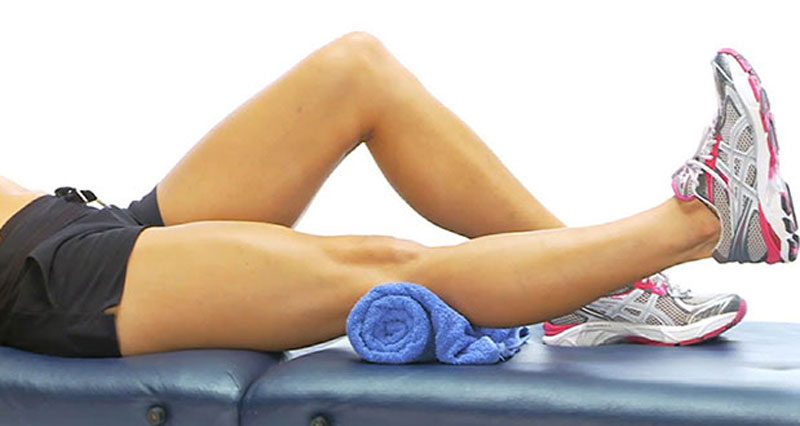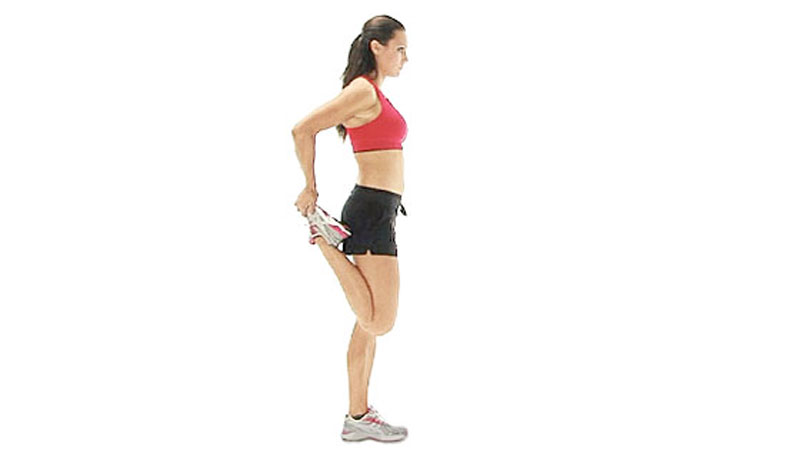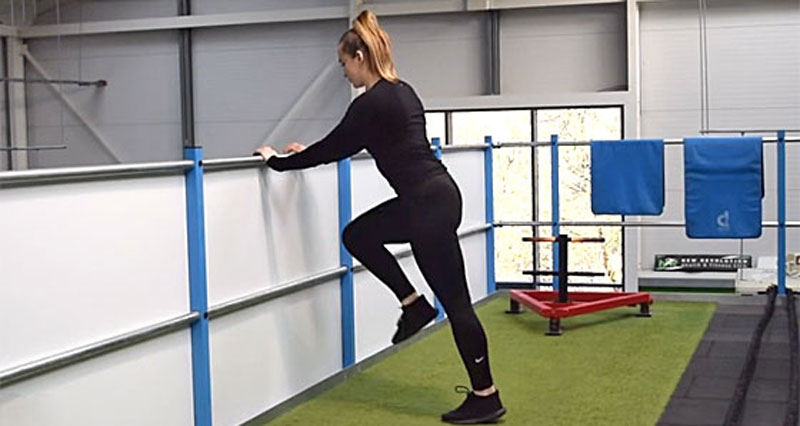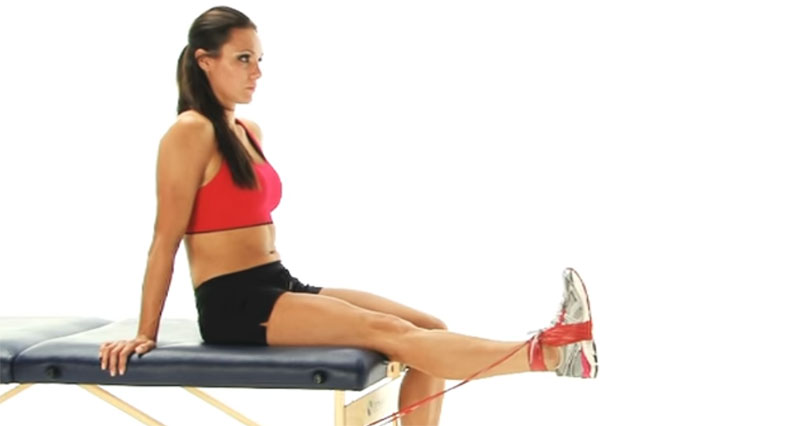Knee strengthening exercises that form part of our knee rehab programs created by elite-level professional sports physiotherapist Phil Pask.
General strengthening and knee injury prevention exercises are separated into early, mid, and late-stage knee rehab exercises. Or select the specific knee rehabilitation program below:
Program author: Phil Pask
Phil is one of the World’s most experienced Sports Physiotherapists. He has been England Senior Rugby Team Physiotherapist since 1997, continuing his role in recent years as Consultant Physio to the team. He was a player, physio, and head of performance at Northampton Saints from 1986 – 2002.

Knee strengthening exercises for specific injuries
Full rehabilitation programs:
- MCL sprain (medial collateral ligament)
- ACL sprain (anterior cruciate ligament)
- LCL sprain (lateral collateral ligament)
- Jumper’s knee/patella tendonitis
- Iliotibial band friction syndrome
- VMO knee strengthening (vastus medialis oblique)
Early-stage knee strengthening exercises
These exercises are more suitable in the early stages of knee rehabilitation. Or if your knee is particularly weak. They are isometric exercises or static contractions. It is important to target the vastus medialis oblique muscle (VMO). This is on the inside of your knee.
VMO inner range quads
Depending on your injury, these exercises are done as soon as pain allows. In some cases, this may be within a day or so of injury after the acute stage has passed.
Position your knee in partial flexion by placing a towel or foam roller underneath. Straighten your knee and hold the contraction for approximately 5 seconds and relax.
VMO with hamstring push
Contract your quadriceps muscles and hold. Simultaneously use your hamstring muscles to push down. Make sure you keep your quads contracted. repeat. Aim for 2 sets of 5 – 6 seconds.
Active straight leg raise
Lie back with both legs out straight. Lift one leg a few inches off the couch/floor, keeping your knee straight. Hold for 5-6 seconds, and lower slowly back to the floor. Aim for 2 sets of 5 – 6 second holds.
Mid-stage knee strengthening exercises
These knee exercises form the main part of any knee rehabilitation program. The aim is to gradually increase the load through your knee joint without injuring soft tissue.
Single-leg quarter squat
Single leg RDL knee strengthening exercise
The RDL or Romanian Deal Lift to give it its full title. The standing leg stays fairly straight. Reach out and backwards with the free leg. Challenges stability around your hips. Aim for 4 sets of 6 to 8 reps.
Step down counterbalance squat front
Step down using a pole as a counterbalance. Perform the movement slowly and controlled. Aim for 3 to 4 sets of (6 to 8 reps for each leg).
Step down counterbalance squat side
Step down to the side using a pole for balance. Perform in a slow and controlled manner. Aim for 3 to 4 sets of (6 to 8 reps for each leg).
Bridge from bench
Place a band around your knees to increase the tension on the outside hip muscles as you perform the exercise. Bridge exercises can be done on the floor, or with feet raised. Aim for 4 sets of 8 – 12 reps.
Dumbbell squat to bench
Legs shoulder-width apart with the toes pointed out slightly. Bend your knees slowly to lower your body down onto the bench until your buttocks touch the bench. Don’t rest on the bench, slowly raise your body back up by pushing through your heels. Aim for 4 sets of 8 – 12 reps.
Bent knee heel raise
Do a heel raise exercise with your knees slightly bent. Progress from double leg heel raises to the single leg as pain allows. Aim for 2 sets of (12 to 18 reps).
Late-stage knee strengthening exercises
These late-stage advanced knee strengthening exercises are more functional and sports-specific. This is because the aim is to restore full strength and mobility to your knee. As a result, bridging the gap between basic knee rehab exercises and full fitness.
Backward lunge with dumbbells
Keep your body upright during movement. Step backwards into a lunge position, hold briefly, and then return to the start position.
Side lunge with weight
Begin by standing with dumbbells at your sides. Stand tall with your feet shoulder-width apart. Bend your left knee as you push your hips back. Keep both feet flat on the floor throughout the lunge. Push off with your left leg to return to standing. Aim for 3 sets of 8 reps.
Single-leg suitcase lift
Use a weight in the same arm and the same leg you are working. Also, as an alternative use a weight in the opposite arm to the leg you are working on. Aim for 3 sets of 6 reps.
Single leg skater squats knee strengthening exercise
Arms folded across your chest, are always a counterbalance. Aim for 3 sets of 6 reps.
Single-leg pistol squats
Bending at the knee, begin to squat down on one leg, extending your non-working leg out in front of your body. Lower yourself down to the bench and repeat. Aim for 3 sets of 6 reps.
Movement control knee exercises
These exercises for the knee improve your balance and coordination. They are also known as proprioception exercises and are important for preventing future knee injuries.
Forward T
Stand on one leg with your knee slightly bent. Lean forwards, open up your arms pulling the non-supporting leg backward to make the shape of a ‘T’. Maintain balance for 4 or 5 seconds and repeat. Aim for 3 sets – 6 reps for each leg.
Forward T to Spiderman
Balance on one leg and move into the ‘Forward T’ position. Hold your balance for a few seconds. Then come up into the upright position. Then, without dropping your foot to the floor move your leg out sideways into the ‘Spiderman’ position and hold. Aim for 2 sets of 6 each leg.
Squat jumps knee strengthening exercise
Use dumbbells if appropriate. This is an advanced exercise, be careful not to overdo it. With a slight bend in your knees, chest up, and feet hip-width apart, hold a pair of dumbbells with straight arms. Bend your knees to perform a squat. Then jump up explosively, landing softly. Aim for 2 sets of 8 reps.
123 hop to stick
Stand on one leg, take one hop, land and hold the position for 2 seconds (to prove you have control). Progress to double hop and stick and three-hops to stick. Aim for 2 sets of 4 reps for each leg.
123 lateral hop to stick
Perform 1 hop sideways to stick. Follow this with 2 hops to stick and 3 hops to stick. Hold the stick position to prove you can balance and control the movement. Aim for 2 sets of 4 reps for each leg.
Lateral crossovers on a step
Step sideways over the box, placing both feet on top each time. Keep light and fast on your toes. Aim for 3 sets of 8 each leg.




